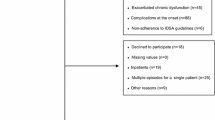Abstract
Background
We treated low-risk febrile neutropenic cancer patients utilizing two standard outpatient antibiotic pathways: oral ampicillin/clavulanate (500 mg) and ciprofloxacin (500 mg) or intravenous ceftazidime (2 g) and clindamycin (600 mg) every 8 h. The objectives were to determine the success of outpatient treatment of low-risk febrile neutropenia, to identify factors predicting outpatient failure, and to determine mortality related to the febrile episode.
Methods
Eligibility criteria included solid tumor diagnosis, stable vital signs, temperature ≥38.0°C, absolute neutrophil count (ANC) of <1000/ml, patient compliance, no significant organ dysfunction, ability to tolerate oral medication and fluids for oral pathway, residence within 30 miles of the institution, 24-h caregiver, and telephone and transportation access.
Results
There were 257 febrile episodes in 191 patients meeting the criteria. Patients were treated during March 1998 through February 2000. Median age was 48 (range, 17–77) years, and 60% (n=153) had an entry ANC of <100/ml; 205 (80%) febrile episodes successfully responded to outpatient treatment, and 52 (20%) were hospitalized. Logistic regression analysis showed the following were related to hospitalization: mucositis >grade 2 (p <0.002); Zubrod performance status ≥2 (p=0.029); ANC <100/ml (p=0.039), and age ≥70 years (p=0.048).
Conclusions
Outpatient treatment of low-risk febrile neutropenic cancer patients utilizing standard treatment pathways is associated with minimal morbidity and mortality and should be considered an acceptable standard of care with appropriate infrastructure available to provide strict and careful follow-up while on treatment. Certain factors are associated with higher risk of hospitalization and should be further examined in eligible patients with low-risk febrile neutropenia.

Similar content being viewed by others
References
Bodey GP, Buckley M, Sathe YS, et al (1966) Quantitative relationships between circulating leukocytes and infections in patients with acute leukemia. Ann Intern Med 64:328–339
Bodey GP, Elting LS, Narro J, et al (1993) An open trial of cefoperazone plus sulbactam for the treatment of fever in cancer patients. J Antimicrob Chemother 32:141–152
Bodey GP, Fainstein V, Elting LS, et al (1990) B-Lactam regimens for the febrile neutropenic patient. Cancer 65:9–16
Bodey G, Reuben A, Elting L, et al (1991) Comparison of two schedules of cefoperazone plus aztreonam in the treatment of neutropenic patients with fever. Eur J Clin Microbiol Infect Dis 10:551–558
Calandra T, Zinner Sh, Vixcoli C, et al (1993) Efficacy and toxicity of single daily doses of amikacin and ceftriaxone versus multiple daily doses of amikacin and ceftazidime for infection in patients with cancer and granulocytopenia. Ann Intern Med 119:584–593
Del Prete SA, Ryan SP, Jacobson JS, et al (1999) Safety and costs of treating neutropenic fever in an outpatient setting. Conn Med 63(12):713–717
Gilbert C, Meisenberg B, Vredenburgh J, et al (1994) Sequential prophylactic oral and empiric once-daily parenteral antibiotics for neutropenia and fever after high-dose chemotherapy and autologous bone marrow support. J Clin Oncol 12:1005–1011
Hidalgo M, Hornedo J. Lumbreras C, et al (1999) Outpatient therapy with oral ofloxacin for patients with low risk neutropenia and fever: a prospective, randomized clinical trial. Cancer 85(1):213–219
Malik IA, Khan WA, Aziz Z, et al (1994) Self-administered antibiotic therapy for chemotherapy-induced, low-risk neutropenia in patients with nonhematologic neoplasms. Clin Infect Dis 19:522–527
Malik IA, Khan WA, Karim M, et al (1995) Feasibility of outpatient management of fever in cancer patients with low-risk neutropenia: results of a prospective randomized trial. Am J Med 98:224–231
Mullen CA, Petropoulos D, Roberts WM, et al (1999) Outpatient treatment of fever and neutropenia for low risk pediatric cancer patients. Cancer 86(1):126–134
NCCN practice guidelines in oncology, vol 1 (2002) Fever and neutropenia. http://nccn.org/physician_gls/f_guidelines.html. Cited 23 July 2003.
Pizzo PA, Hathorn JW, Hiemenz J, et al (1986) A randomized trial comparing ceftazadime alone with combination antibiotic therapy in cancer patients with fever and neutropenia. N Engl J Med 315:552–558
Rolston KVI, Berkey P, Bodey GP, et al (1992) A comparison of imipenem to ceftazidime with or without amikacin as empiric therapy in febrile neutropenic patients. Arch Intern Med 152:283–291
Rolston KVI, Rubenstein EB, Elting LS, et al (1995) Ambulatory management of febrile episodes in low-risk neutropenic patients. In: Programs and Proceedings of the 35th Interscience Conference on Antimicrobial Agents in Chemotherapy, San Francisco, CA, p.333, abstract no. 2235
Rubenstein EB, Rolston K, Benjamin RS, et al (1993) Outpatient treatment of febrile episodes in low-risk neutropenic patients with cancer. Cancer 71:3640–4366
Talcott JA, Finberg R, Mayer RJ, et al (1968) The medical course of cancer patients with fever and neutropenia. Arch Intern Med 148:2561–2568
Talcott JA, Siegel RD, Finberg R, et al (1992) Risk assessment in cancer patients with fever and neutropenia: A prospective, two-center validation of a prediction rule. J Clin Oncol 10:316–322
Walter TH, Armstrong A, Bodey, GP, et al (2002) Guidelines for the use of antimicrobial agents in neutropenic patients with cancer. Clin Infect Dis 34:730–751
Winston DJ, Ho WG, Bruckner DA, et al (1991) Beta-lactam antibiotic therapy in febrile granulocytopenic patients. Ann Intern Med 115:849–859
Zubrod CG, Schneiderman M, Frei E, et al (1960) Appraisal of methods for the study of chemotherapy of cancer in man: comparative therapeutic trial of nitrogen mustard and trimethylene thiophosphoramide. J Chronic Dis 11:7
Author information
Authors and Affiliations
Corresponding author
Additional information
Presented at the 2002 American Society of Clinical Oncology, Orlando, Florida, USA.
Rights and permissions
About this article
Cite this article
Escalante, C.P., Weiser, M.A., Manzullo, E. et al. Outcomes of treatment pathways in outpatient treatment of low risk febrile neutropenic cancer patients. Support Care Cancer 12, 657–662 (2004). https://doi.org/10.1007/s00520-004-0613-6
Received:
Accepted:
Published:
Issue Date:
DOI: https://doi.org/10.1007/s00520-004-0613-6




